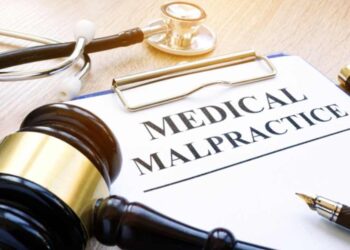Exploring the legal labyrinth of filing a personal injury claim in Montgomery County can seem intimidating, particularly when you’re trying to recover from an injury. From gathering pertinent evidence to negotiating a fair settlement, each step presents its own set of challenges and intricacies. As we guide you through this process, you’ll uncover the important role of timely actions, the value of professional legal advice, and the significance of meticulous documentation in securing a positive outcome for your claim. Are you ready to embark on this journey of understanding this complex, yet vital process?
Understanding Personal Injury Claims
Understanding the intricate maze of personal injury claims necessitates a thorough grasp of the legal process, the specific requirements in Montgomery County, and the potential outcomes of your case. In Montgomery County, the breadth of claim types is extensive, ranging from automobile accidents, workplace injuries, medical malpractice to defective products, and more. Each claim type has its unique nuances and injury laws that govern how the claim is processed and settled.
Injury laws in Montgomery County are designed to protect the rights of victims, holding those responsible for their injuries accountable. These laws outline the process for determining liability, evaluating damages, and awarding compensation. It’s important to understand that different claim types are regulated by distinct statutes of limitations and damage caps.
Navigating through the complex process of filing a personal injury claim can be challenging without a thorough understanding of these various claim types and injury laws. Hence, it’s advisable to seek professional legal advice to make sure you are accurately informed and equipped to pursue your claim effectively.
When to File a Claim
Recognizing the appropriate time to file a personal injury claim is an important step in the pursuit of justice and compensation for your damages. In Montgomery County, there are specific claim deadlines that must be adhered to. Generally, claimants have two years from the date of the injury to file a claim against the party responsible for their harm. This deadline, known as the statute of limitations, is a strict rule, and missing this window can lead to the dismissal of your case.
The severity of your injury also plays a significant role in determining when to file a claim. If your injury is severe, it’s advisable to start the claim process immediately after seeking initial medical treatment. This is because severe injuries often result in substantial medical costs, lost income, and other damages that can cause significant financial strain.
Gathering Essential Evidence
Often, the success of a personal injury claim hinges on the quality and quantity of evidence collected to substantiate the claimant’s allegations of fault and damages. Accumulating a thorough body of evidence can greatly enhance the persuasiveness and credibility of your claim, leading to a more favorable resolution.
Witness testimonies form an integral part of this evidence. If possible, obtain statements from individuals who witnessed the incident. Their detailed accounts can provide an unbiased perspective of the event, strengthening your argument about the other party’s liability. In addition, make sure that you preserve any physical evidence from the scene, such as damaged property or clothing.
Simultaneously, record your insurance discussions. Keep meticulous notes about every conversation you have with your insurance company. Note the date, time, the person you spoke with, and the specifics of the discussion. This can prove critical if the insurer later disputes the facts or terms of your discussions.
Lastly, gather all pertinent documentation, such as medical bills, repair estimates, and proof of lost wages. These documents play a key role in establishing the extent of your financial loss and the compensation you are entitled to claim. The more evidence you amass, the more robust your claim will be.
Documenting the Injury
Recording the injury is a vital aspect of filing a personal injury claim in Montgomery County. This process not only involves the meticulous collection of relevant medical records but also requires the careful photographing of any visible injury evidence. Precise and thorough documentation can greatly enhance your claim, enabling the court to fully understand the extent of your physical suffering.
Gathering Relevant Medical Records
Obtaining all pertinent medical records is an essential step in substantiating your personal injury claim in Montgomery County. These records serve as undeniable proof of your injury, the treatment received, and the subsequent costs. They also aid in the process of medical bill interpretation, a critical aspect when calculating the total compensation you are due.
To collect these records, you will need to communicate effectively with healthcare providers and your insurance company. This task might seem challenging, but with effective insurance communication strategies, it becomes manageable. Start by requesting copies of all medical reports, test results, prescriptions, and payment receipts related to your injury. These documents detail the extent of your injury, the treatment protocol followed, and the associated costs.
Photographing Injury Evidence
Capturing visual evidence through photography serves as an important tool in your personal injury claim, providing tangible proof of the harm inflicted and the resultant damage. The accuracy of the captured images can greatly influence the outcome of your case. Hence, it’s essential to follow proper evidence preservation techniques.
Begin by photographing the injuries as soon as possible to document their initial severity. Don’t neglect the progression of the injuries over time, as this can highlight the ongoing impact on your life. Capture different angles and distances, ensuring the images are clear and focused. Use date and time stamps to provide a chronological record.
Photography legalities should also be considered. While it’s vital to obtain detailed evidence, respect privacy rights. Do not take photos that infringe on others’ rights or in prohibited areas without consent. Also, avoid manipulating the photos as this can lead to legal issues and compromise your claim’s credibility.
Reporting the Incident
After an incident resulting in a personal injury, it is essential to promptly report the event to the appropriate authorities, thereby ensuring an accurate and timely record of the incident. This process often involves police interaction, which is vital to the successful filing of a personal injury claim. If you’re able, it’s recommended that you provide the police with a thorough account, including the incident location, circumstances, potential witnesses, and any perceived negligence on part of the other party.
Remember, the report filed by the police serves as an official record of events and can greatly strengthen your claim. It is also beneficial for establishing facts that might otherwise be disputed later on. If your injuries prevent you from reporting the incident immediately, do so as soon as you’re physically able.
Be sure to request a copy of the report for your records. This document can play a pivotal role in negotiations with insurance companies or during a court trial. Reporting the incident promptly and accurately, as such, not only secures a reliable record but also bolsters your position when seeking rightful compensation for your injuries.
Choosing a Personal Injury Lawyer
Understanding the complexities of a personal injury claim can be challenging; thus, selecting a skilled personal injury lawyer is an important step towards ensuring your rights are protected and you receive the compensation you deserve. A competent lawyer will guide you through the legal maze, making it easier for you to navigate the intricacies of the claim process.
When choosing a lawyer, take into account their experience, client testimonials, and their track record in handling personal injury claims. It’s vital to establish their expertise in personal injury law, as this will greatly impact the outcome of your claim. For those seeking specialized assistance, consider reaching out to personal injury attorneys in Montgomery County who are well-versed in local legal intricacies.
Lawyer’s fees are another important aspect to bear in mind when selecting your legal representative. Some lawyers operate on a contingency basis, meaning they only get paid if they win your case. It’s crucial to understand the fee structure and any potential costs upfront to avoid any surprises later on.
Lastly, legal ethics should not be overlooked. A lawyer with a strong ethical code will handle your case professionally, maintaining confidentiality, and ensuring your best interests are always prioritized. Ensuring you choose an experienced, ethical, and financially transparent lawyer will greatly enhance your chances of a successful personal injury claim.
Initiating the Claim Process
Having selected a competent personal injury lawyer, the next step in securing your rightful compensation is to initiate the claim process. This pivotal phase, known as claim initiation, involves several legal requirements that are essential to achieving a positive outcome.
Firstly, you must establish and document every detail of the incident leading to your injury. This includes the date, location, people involved, and the circumstances surrounding the event. A thorough record of these details will form a strong foundation for your claim.
Secondly, you need to gather all medical records associated with your injury. This includes diagnosis, treatment, recovery period, and any ongoing therapies or medications. These records will serve as evidence of your injuries and their impact on your life.
Lastly, you should start calculating the financial repercussions of the injury. This includes medical bills, loss of income, and any other expenses related to your injury. This step is crucial in determining the amount of compensation you may be entitled to.
Failure to adhere to these legal requirements can jeopardize your claim. Hence, it is vital to work closely with your lawyer throughout the claim initiation process to ensure all requirements are met, and your rights are protected.
Negotiating a Settlement
Mastering the intricacies of settlement negotiation is a crucial aspect of a personal injury claim. By incorporating successful negotiation strategies, the chances of achieving a favorable resolution can be greatly enhanced. This discussion will provide a comprehensive understanding of these strategies and how to apply them in the context of Montgomery County.
Understanding Settlement Negotiation
Delving into the intricacies of settlement negotiation is an essential step in the personal injury claim process, as it allows parties to resolve disputes without resorting to potentially costly and time-consuming court proceedings. Understanding negotiation tactics and being aware of potential settlement delays is vital in maneuvering through this process.
Settlement negotiation involves discussing the claim and reaching an agreement on compensation. This is where negotiation tactics come into play. The goal is to persuade the other party of the validity and value of your claim. It’s not uncommon for insurance companies to employ delay tactics, hoping the claimant will accept a lower settlement out of desperation.
Being prepared for settlement delays can protect you from hastily accepting a less than favorable settlement. These delays can be due to various reasons such as administrative backlog, disputes over liability, or complexity of the injury. Understanding these variables can equip you with the patience and persistence needed to secure a fair settlement.
Effective Negotiation Strategies
Mastering effective negotiation strategies is vital in ensuring that your personal injury claim results in an equitable settlement. A keen understanding of negotiation psychology can play a pivotal role in this process. This involves recognizing the behavioral patterns, emotions, and thought processes of the opposing party, which can greatly influence the negotiation outcomes.
Possessing excellent communication skills is another essential element in negotiation. It is important to clearly articulate your demands, substantiate your claims with concrete evidence, and remain calm and composed, even under pressure. Active listening is equally important; understanding the other party’s perspective can help you devise a more effective negotiation strategy.
It’s also advisable to set realistic expectations and be prepared to compromise. Remember, the goal is not to ‘win’ the negotiation, but to reach a fair and reasonable settlement that adequately compensates for your losses.
Preparing for Trial
Understanding the intricacies of trial preparation can be essential in ensuring a successful outcome for your personal injury claim in Montgomery County. A significant part of this process involves thorough understanding and management of trial logistics. This includes, but is not limited to, grasping the trial process, preparing your evidence, and being aware of the expected timeline.
Witness preparation is another vital component. A well-prepared witness can provide compelling testimony, strengthening your case significantly. This involves ensuring they understand the nature of the trial, the questions they may be asked, and the best way to present their testimony.
Furthermore, it is advisable to familiarize yourself with the courtroom environment. This includes knowing where the trial will be held, the layout of the courtroom, and the expected demeanor and conduct. A professional attorney can assist you in maneuvering through these complexities, providing valuable guidance every step of the way.
Managing Post-Settlement Tasks
What happens after a personal injury claim settlement in Montgomery County? The aftermath of a settlement involves tasks that are as vital as the preceding steps. This phase, commonly known as ‘Managing Post-Settlement Tasks’, requires meticulous attention to guarantee compliance with all legal obligations.
Firstly, one has to navigate post-settlement taxation. The law mandates that a portion of your settlement may be taxable. It is advisable to consult with a tax professional to understand your tax obligations and to avoid any potential penalties. The specifics of your settlement, including what it was awarded for, will determine its taxability.
Secondly, asset management becomes a primary concern. The settlement received is not just a compensation for the injury suffered, but also a financial asset that needs proper management. Making informed decisions about how to best use or invest the settlement can greatly impact your financial future. It’s important to seek the advice of a financial advisor or asset management professional to help you make the most of your settlement.
Frequently Asked Questions
What Are the Tax Implications of a Personal Injury Settlement?
In general, the settlement gross amount from a personal injury claim is not taxable. However, certain deductible expenses related to the claim, such as legal fees or medical bills, may have tax implications.
Can I Still File a Claim if Im Partially at Fault for the Accident?
Yes, you can still file a claim if partially at fault. Montgomery County applies the ‘comparative negligence’ rule, meaning your compensation may be reduced based on your fault percentage in the accident.
How Can Emotional Distress Be Proven in a Personal Injury Claim?
Emotional distress in a personal injury claim can be proven through distress documentation such as medical records, therapy notes, and personal journals. Witness testimony can further substantiate the claim, offering a thorough view of the distress experienced.
Can a Personal Injury Claim Affect My Current Employment?
A personal injury claim should not affect your current employment due to employment discrimination laws. Nonetheless, privacy concerns may arise if the case becomes public, potentially impacting professional relationships and perceptions in the workplace.
What Happens if New Injuries Related to the Accident Are Discovered After Settlement?
If new injuries related to the accident are discovered post-settlement, the injury timeline and subsequent diagnosis becomes essential. Generally, it’s challenging to reopen a settled claim, emphasizing the importance of thorough medical evaluations beforehand.










